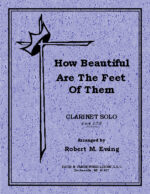-
Higher Ground
$5.50A rather jovial introduction is begun by the piano and then joined in by the soloist stating the melody’s verse and then the chorus in a modified form. The second verse is presented in a pleasing way underpinned by the piano using a harp-like accompaniment. And once again, the chorus is presented in a even more modified way. The coda section continues with the flavor of the piece in a motivic manner and then arrives to the final destination in repose.
-
My Faith Has Found A Resting Place
$5.50This clarinet solo begins with a brief piano introduction and presents the tune in a gently embellished manner that creates interest. After a brief intermission the soloist presents the tune with even more melodic embellishment and ryhthmic activity. Another intermission coupled with a modulation where the piano now carries the tune while the soloist offsets it with a countermelody, The solo line now captures the tune and carries it to the end where it makes a final, restful statement.
-
Satisfied
$4.50This solo begins with a elegant little motif in the upper register of the piano and then moves downward to a simple accompanying figure. The solo enters in a gentle manner with minor modifications- very much in a restful manner. With an abrupt modulation the tune is modified once more in a different way. After two more modulations in the piano the soloist presents the tune with a more “arpeggiated” way and then settles into a final long note- as if “everything’s okay!”
-
What A Friend
$4.50This solo begins with a polite introduction and then is joined with the soloist in a gentle alteration of the tune in its entirety. A second verse is modulated upward with the tune with even more variation. After more modulations there is a brief cadenza and then a coda section based on the opening motif of the tune.
-
Sunday School Parade
$4.50The effect of a parade coming and going… using: Jesus Loves The Little Children; Onward Christian Soldiers; I’ve Got the Joy, Joy, Joy
-
-
Come Thou Fount
$4.50This bubbly rendition of “Come Thou Fount” is effervescent from beginning to end. It is filled with movement and excitement expressing intense joy throughout.
-
Like A River Glorious
$4.50This is a clarinet solo that begins in a flowing manner and quickly accelerates to a more technical rendition of the tune creating a delightful atmosphere of this grand old hymn. It is effervescent and uplifting.
-
I Need Thee Every Hour
$5.00Although the melody is gently modified, this solo with piano displays both a sensitivity along with an elevated soaring quality expressing the need for divine interaction on the part of humanity.
-
Amazing Grace
$5.00This solo opens with a gentle, Celtic fashion in a duple meter. It progresses through a series expressive obbligati giving a sense of elevation. As it nears the end it modulates metrically and harmonically to a triple meter, and then final repose.
-
All The Way Medley
$4.50An accompanied clarinet solo that includes the hymns, “Jesus Led Me All The Way,” and “All the Way My Savior Leads Me.” After a brief intro of “All The Way…” the soloist enters with “Jesus Led…” in a straight forward manner. Then a brief interlude the solo ist then presents “All The Way…” in a new key- much the same manner as the first tune. The Coda section is based on “Jesus Led…” in a more altered and varied manner and then comes to a sweet ending.
-
O The Deep Deep Love Of Jesus
$4.50This piece would serve well as a meditation. Beginning with a quiet Celtic lilt, the center section is stronger and bolder. After several bell effects, the piece returns to the mood of the beginning.
-
How Beautiful Are The Feet
$4.00Taken from the “Messiah”, this solo with piano is essentially a transcription of the original work. The balance in the writing between the solo and the accompaniment gives way to the sensitivity of the text of this well-know aria..
-
-
Jesus Loves Me
$4.00This solo with piano is constructed in a rondo form alternating the tunes of Jesus Loves Me, Praise Him All Ye Little Children and Jesus Loves The Little Children. Each section of piece is in a different style thereby giving a great deal of variety technically and musically for the younger player.
-
Tis So Sweet to Trust in Jesus
$3.50This solo with piano is structured in a quasi-rondo form. Thus making a great deal of variety in texture, style, and dynamic.It will make the young performer sound more advanced.
-
My Jesus I Love Thee
$3.50This solo with piano begins with a modified melodic statement. It enters into a second section with simple obligati and then returns to a beginning-like statement and ends with a simple coda.
-
Abide With Me
$3.50This solo piece with piano is presented in a straight-forward manner for the younger player with some altered pitches for interest.
-
Dare To Be A Daniel
$3.50This solo with piano begins with the strains of a lion’s roar. Next enters Daniel in a simple fashion followed by a statement in a triumphal march. The lions return-Daniel prevails.
-
Praise Him All Ye Little Children
$3.50This solo with piano begins with a bold march statement with an elongated rhythm of the melody. The middle section is more expressive while the final section imitates the beginning, with a solid statement of faith.
-
Holy, Holy, Holy
$3.50This solo with piano is straight forward in design, giving the young player the opportunity to display dynamic and stylistic variety.
-
Rejoice Greatly Ye Daughters of Zion
$6.50Taken from the “Messiah”, this bassoon solo with piano is essentially a transcription of the original work. The balance in the writing between the solo and the accompaniment gives way to the sensitivity of the text of this well-know aria..

























